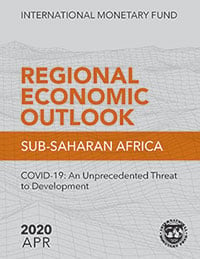
Sub-Saharan Africa
COVID-19: An Unprecedented Threat to Development
April 2020
• The COVID-19 pandemic threatens to exact a heavy human toll, and the economic crisis it has triggered can upend recent development progress.
• Growth in sub-Saharan Africa in 2020 is projected at –1.6 percent, the lowest level on record.
• The policy priority is to ramp up health capacity and spending to save lives and contain the virus outbreak.
• Support from all development partners is essential to address the sizable financing needs, including debt relief for the most vulnerable countries.
• Fiscal, monetary, and financial policies should be used to protect vulnerable groups, mitigate economic losses, and support the recovery. Once the crisis subsides, fiscal positions should return to sustainable paths.
Chapter 1: COVID-19: An Unprecedented Threat to Development
Sub-Saharan Africa is facing an unprecedented health and economic crisis that threatens to throw the region off its stride, reversing the development progress of recent years and slow the region’s growth prospects in the years to come. The COVID-19 pandemic has spread through almost all countries. And as in the rest of the world, the health crisis has precipitated an economic crisis reflecting three large shocks: disruption of production and a sharp reduction in demand; spillovers from a sharp deterioration in global growth and tighter financial conditions; and a severe decline in commodity prices. As a result, the region’s economy is projected to contract by 1.6 percent this year—the worst reading on record. The economic crisis will exacerbate social conditions and aggravate existing economic vulnerabilities, while containment measures and social distancing will inevitably jeopardize the livelihoods of countless people. Decisive measures and support from the international community are urgently needed to limit the humanitarian and economic losses and protect the most vulnerable societies.
Chapter 2: Adapting to Climate Change in Sub-Saharan Africa
Sub-Saharan Africa is especially vulnerable to climate change, as it relies heavily on rain-fed agriculture and has limited resilience and coping mechanisms. On average, climate change could reduce GDP growth by at least 1 percentage point in the month a climate shock occurs. Improving access to finance and insurance, education, health, telecommunications, and physical infrastructure would be most effective in raising resilience. Ensuring food security and raising agricultural productivity in the face of intensifying weather shocks will require targeted social assistance, crop diversification, and improved irrigation. While these measures involve large public spending, they should be prioritized as they will be more cost-effective than frequent disaster relief. Limited fiscal space poses a challenge and means that development partners’ support will be critical.
Chapter 3: Digitalization in Sub-Saharan Africa
Sub-Saharan Africa is rapidly becoming digitally connected and closing gaps with the rest of the world. Digital solutions have taken on added importance as countries grapple with the unprecedented fallout of the COVID-19 pandemic. While countries have leveraged digital solutions and policy responses, the connectivity gap between sub Saharan Africa and the rest of the world suggests that greater digital readiness could have allowed the region to do even more. Analysis conducted before the pandemic found that a one percentage point increase in internet penetration in the region can raise per capita growth by 0.1–0.4 percentage points. There does not appear to be an impact on overall employment, although the share of service sector jobs increases. Evidence suggests that digitalization can help reduce corruption, improve public sector accountability and efficiency, and support financial development. However, digitalization brings new risks (e.g., cybersecurity, business continuity) and challenges to macro-policy making (e.g., monetary policy transmission, changes to the tax base). As attention turns to policies for the recovery, the pandemic will likely serve to accelerate the digital transformation. Policies to enable and leverage greater connectivity include investing in complementary infrastructure and human capital; developing legislative and regulatory frameworks; and supervisory powers to ensure consumer protection and address risks.



